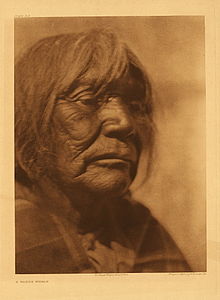User:Anniepaints/sandbox/sandbox
History[edit]

The Washoe people share similarities with Great Basin and California groups, but are quite unique. The family unit is the core of the Washoe tribe.[1] Washoe families or kinship groups were the backbone of Washoe society, and families would band together for defense, hunting, fishing, and harvesting.[2]
Washoe people are the only Great Basin tribe whose language is not Numic, so they are believed to have inhabited the region prior to neighboring tribes. The Kings Beach Complex that emerged about 500 CE around Lake Tahoe and the northern Sierra Nevadas are regarded as early Washoe culture. The Martis complex may have overlapped with the Kings Beach culture, and Martis pit houses gave way to conical bark slab houses of historic Washoe culture.[3]
Warfare between the Washoe people and neighboring tribes was not common, although territorial skirmishes did occur.[4]
Since the Washoe were surrounded by Numic speakers to the north, south, and east and other languages to the west, the Washoe were insulated from the growing influence of the Spanish, French, and English for some time,[5] remaining extremely isolated and autonomous up until the arrival of the Americans in the 1800s.
Where other nearby tribal groups adopted horses, the Washoes did not. Although horses allowed other tribes to trade and travel quickly, horses were impracticable in the steep mountain terrain of the Sierra Nevada and would have been difficult to feed year-round.[6]
The first documented account of Americans meeting Washoes was in May of 1827, when Jedediah Smith, a traveling fur trapper, struggled through Washoe lands during a rainstorm.[7] Later, a surveying expedition led by John Charles Fremont encountered the Washoe people in January of 1844. The establishment of a Mormon trading post in 1851 led to the first permanent American colony in Washoe country.[8] That trading post was commonly called Mormon Station and was later renamed Genoa.
Washoe people may have made contact with Spanish explorers in the early 19th century, but the Washoe did not sustain contact with people of European culture until the 1848 California Gold Rush.[9] Washoe resistance to incursions on their lands proved futile, and the last armed conflict with the Washoes and non-Indians was the Potato War of 1857, when starving Washoes were killed for gathering potatoes from a European-American farm near Honey Lake in California.[10]
Loss of the valley hunting grounds to farms and the piñon pine groves to feed Virginia City's demand for lumber and charcoal drove most Washoe to dependency on jobs on white ranches and farms and in cities. The areas where they settled became known as Indian colonies.
- ^ "Washoe History: A Brief Summary". Washoe Tribe Home. Retrieved 3 June 2019.
- ^ Makley, Matthew (2018). The Small Shall Be Strong. Amherst: University of Massachusetts Press. p. 23. ISBN 9781625343475.
- ^ D'Azevedo 466
- ^ Makley, Matthew (2018). The Small Shall Be Strong. Amherst: University of Massachusetts Press. p. 33. ISBN 9781625343475.
- ^ Makley, Matthew (2018). The Small Shall Be Strong. Amherst: University of Massachusetts Press. p. 33. ISBN 9781625343475.
- ^ Makley, Matthew (2018). The Small Shall Be Strong. Amherst: University of Massachusetts Press. p. 34. ISBN 9781625343475.
- ^ Makley, Matthew (2018). The Small Shall Be Strong. Amherst: University of Massachusetts Press. p. 38. ISBN 9781625343475.
- ^ Makley, Matthew (2018). The Small Shall Be Strong. Amherst: University of Massachusetts Press. p. 48. ISBN 9781625343475.
- ^ Cite error: The named reference
p246was invoked but never defined (see the help page). - ^ D'Azevedo 494
